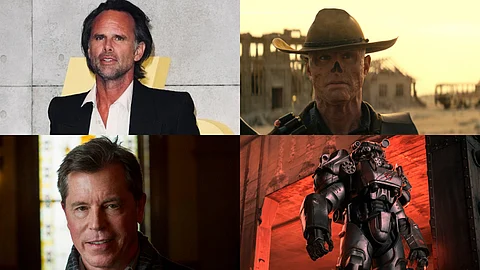

The biggest existential threat to humanity finally arrives and the world is horribly maimed after an all-out nuclear exchange. Two centuries later, survivors carve a life out for themselves inside sophisticated underground bunkers called vaults, while the outside world is plagued by lethal radiation and mutated life forms. Such is the world of Fallout. However, even with a nightmare-ish setting, the Prime Video series is no mere survival thriller. “The tone of the show is satirical-absurdist-subversive humour,” says Walton Goggins, who plays the mutated gunslinger Ghoul in Fallout. Howard Cummings, the production designer of the series concurs with this description. “When I read the script, I noticed it had all this crazy humour and these satirical absurdist elements. At its heart, Fallout is a comedy and Jonathan (Nolan) is not someone who is known for humour. So I was surprised we were approaching it from this angle.” Cummings has a long working history with Jonathan Nolan, the creator of the show. They previously worked together on the sci-fi show Westworld, which marries tonally contrasting genres like sci-fi and Western, an element that recurs in Fallout as well. As someone who has appeared in numerous Westerns like The Hateful Eight (2015), Cowboys and Aliens (2021), and Django Unchained (2012), Goggins explains how his knowledge of the genre informed his performance as a gunslinger in Fallout. “The Western elements of Fallout are built into the show so organically. It is one of my favourite genres and I have been fortunate enough to appear in some great Westerns but I’ve made sure this is not a repeat of those performances. But on some level, Ghoul was absolutely informed by my previous performances in Westerns.” The actor makes it a point to note how the Ghoul is also a man named Cooper Howard, who goes through mutation after the nuclear exchange. He describes portraying Ghoul/Cooper Howard as a “Profound joy and yet very difficult to pull off”. Goggins ascribes the difficulties of playing the Ghoul to the prosthetic makeup and the gun training he had to go through. As for the psychology of the character, he says, “Everything Cooper was before the bombs dropped, goes on to inform everything about who the Ghoul is now.”
While the series is an adaptation of the popular video game franchise of the same name, Walton Goggins went through a classic approach to prepare for his role as a gunslinger/bounty hunter. “I just watched a lot of movies.” From Sergio Leone’s Spaghetti Westerns to films like High Noon (1952) and studying the performances of Alan Ladd in Shane (1953), Goggins claims to have watched around 50 films, most of which he had already seen, to prepare for the role. The actor goes on to credit two celebrated performances as the biggest references for Ghoul: Paul Newman in Butch Cassidy and the Sundance Kid (1969) and Henry Fonda in Once Upon A Time In The West (1968). “Ghoul is a scoundrel. And nobody is a rascal the way Paul Newman is in Butch Cassidy… I wanted people to love the Ghoul as well as be scared of who he is as a person, so I had to lean into his personality and charisma. There is a part of Ghoul’s personality that is extremely funny.” To tap into the ominous nature of Ghoul, Goggins watched Henry Fonda’s performance as the antagonist in Sergio Leone’s Once Upon A Time In The West. “When his character kills a little boy in the beginning of the film and he walks into the frame, it is extremely chilling. There is a slow coolness to everything he does and I wanted to adopt that.” Goggins recounts the initial discussions with Jonathan Nolan regarding Ghoul. “We thought Ghoul should have an economy of movement. He is a character who doesn’t move until he needs to.”
The tremendous attention to detail that went into designing the characters is an approach that was used in designing the visual language of Fallout as well. “Jonathan (Nolan) was particular about shooting the series on film,” says production designer Howard Cummings. He further states, “Even though the show demanded a lot of visual effects, we shot a lot of it on a digital stage called Volume where digital environments are projected on sound stages.” The cutting edge technology is recently used in projects like The Mandalorian (2019) and The Batman (2022). From building a practical Power Armour to shooting in the difficult terrains of Namibia, the Fallout team went to great lengths to make everything inside a frame as realistic as possible.
On the note of realism, Goggins signs off on a pensive note, “The world is a very scary place right now and this is the closest we have ever been to a world like the one we see in Fallout. So often, art mirrors the times we are living in. But in the case of Fallout, we would rather the show does not end up reflecting our reality in the future.”